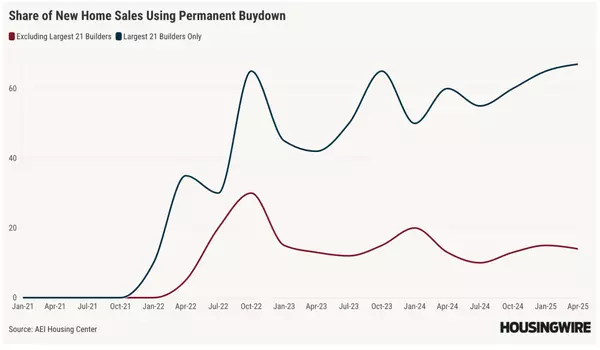Why fiduciary duty and communication matters more than ever in real estate

At the core of real estate lies one constant: our duty to communicate clearly, act with integrity, and put our clients first. When those principles slip—even unintentionally—the results can be costly. Not long ago, a situation discussed during one of our coaching calls served as a powerful reminder
Read MoreAtlantic Coast Mortgage acquires Tidewater Mortgage

Atlantic Coast Mortgage LLC, a Fairfax, Virginia-based mortgage lender licensed in 40 states, has acquired Tidewater Mortgage Services Inc., a coastal Virginia lender serving the Mid-Atlantic and Southeast regions. The deal, announced on Monday, combines Atlantic Coast Mortgage’s technology-driven l
Read MoreHousing inventory falls as demand picks up
Last week, housing inventory levels decreased noticeably, while our weekly pending sales showed a notable increase compared to the same period last year. Was the decrease in inventory primarily due to the seasonal decline in housing stock, or did the increase in demand contribute to lowering the inv
Read MoreA 50-year mortgage could double your interest payment

In a social post on Saturday, President Trump floated the idea of a 50-year mortgage to boost housing affordability, but the idea got a frosty reception online. One reason is that stretching the loan term out that long ends up costing much more in interest over the life of the loan while only shavin
Read MoreTrump proposes 50-year mortgage to help affordability

Trump on Saturday posted an image on social that seemed to suggest he would be proposing 50-year mortgages, something FHFA Director Bill Pulte confirmed shortly after on X. The image Trump posted on Truth Social features a head shot of President Franklin Delano Roosevelt under the title 30-year mort
Read MorePulte says Fannie, Freddie to remain in conservatorship with IPO plans

FHFA Director Bill Pulte said Friday that Fannie Mae and Freddie Mac will remain in conservatorship, but that the government would seek to sell up to 5% of their shares. Pulte made the remarks at the ResiDay conference in New York City, according to posts on X by ResiClub Co-founder Lance Lambert. L
Read MoreStewart acquires MCS’s mortgage services business for $330 million

Title and real estate services company Stewart Information Services Corp., owned by SISCO Holdings, has entered into an agreement to acquire the mortgage services of property preservation provider Mortgage Contracting Services (MCS) for $330 million. The transaction, announced Friday, expands Stewar
Read MoreOpendoor hits reset: The iBuyer goes full founder mode with new CEO

Opendoor’s recently appointed CEO Kaz Nejatian used the firm’s third-quarter earnings call with investors and analysts to introduce himself and reintroduce the company he has been tasked with turning around. “I’m a computer nerd turned lawyer, turned founder, but I think of myself primarily as a pr
Read MoreExclusive: NFM Lending grows footprint with Homespire Mortgage acquisition

Two Maryland-based retail mortgage lenders struck an M&A deal this week as NFM Lending has agreed to acquire Homespire Mortgage, the companies confirmed on Friday. The financial terms were not disclosed. With the acquisition, Linthicum-based NFM will expand its presence along the East Coast, while H
Read MoreReal, former CFO settle wrongful termination lawsuit

The Real Brokerage and its former chief financial officer Michelle Ressler have reached a settlement agreement in the lawsuit Ressler filed in early June 2025. Filed in the U.S. District Court for the Southern District of New York, the lawsuit claims that Real orchestrated Ressler’s termination und
Read MoreWhat Realtors really think about working with builders

Picture this: a Realtor® walks into a new-home sales office, client in tow, ready to collaborate. The builder’s rep glances up from the desk, wary smile in place. Both sides want the same thing — a sold home — but the air crackles with tension. That moment, repeated across the country, defines one o
Read MoreLongbridge has record quarter for proprietary volume, posts $8.6M profit

Ellington Financial reported strong financial performance from its reverse mortgage subsidiary, Longbridge Financial, during its third-quarter earnings call on Thursday. Longbridge posted net income of $8.6 million from July through September — down from the $10.7 million profit it achieved in the s
Read MoreOpendoor, Roam team up to expand assumable mortgage access

Opendoor is teaming up with Roam, a platform that enables homebuyers to purchase homes with assumable low-rate mortgages, according to an announcement on Friday. Through this partnership, Roam’s assumable mortgage tools and transaction support will be available to homebuyers shopping for homes on O
Read MoreDavid Conroy rejoins NAR as first-ever chief data officer

The National Association of Realtors (NAR) continues to shake up its executive team. On Friday, the firm announced the appointment of its first-ever Chief Data Officer David Conroy. In addition to serving at CDO, Conroy will also serve as the senior vice president of strategy and innovation. The tr
Read MoreFlorida housing market slows as listings rise and sales drop

Florida’s single-family housing market revealed a striking disconnect in early November 2025, with homes taking a median 98 days to sell, 21 days longer than the national median of 77 days, even as market conditions shifted decisively in favor of buyers. The state’s housing inventory reached 97,224
Read MoreloanDepot’s Q3 loss narrows as revenue climbs 14%

loanDepot reported a smaller loss in the third quarter as higher loan volumes, improved margins and increased servicing income boosted its results. Revenue for the California-based mortgage lender rose 14% from the previous quarter to $323 million, while adjusted revenue increased 11% to $325 millio
Read MoreBlend Labs reports shrinking mortgage revenue even as its partnerships gain steam

Blend Labs Inc. shared its third-quarter earnings on Thursday afternoon, posting revenue of $32.9 million from July to September, down 1% on an annual basis. The company reported a GAAP gross profit margin of 74% in the third quarter, unchanged from the same period in 2024. Non-GAAP gross profit mar
Read MoreWhy Springfield homes sell faster than Illinois average

The Springfield, IL metro housing market recorded a median days on market of 28 days for the week ending Nov. 7, 2025, moving faster than the Illinois state median of 49 days. The accelerated sales pace comes as the metro’s median list price sits at $199,700, well below the state median of $309,900.
Read MoreHow Terre Haute market defies trends with faster sales and price gains

The Terre Haute,IN metro housing market is moving at a notably quicker pace than the rest of Indiana, with homes selling in a median of 42 days compared to 56 days statewide as of Nov. 1, 2025. This faster sales velocity comes even as the metro’s median list price climbed 11.5% year over year to $17
Read MoreRithm drops Onity as subservicer on $33B portfolio

Rithm Capital will no longer use Onity Group’s servicing subsidiary, PHH Mortgage Corp., as the subservicer of a $33 billion portfolio primarily composed of pre-2008 loans — ending an agreement that has lasted nearly a decade. Onity, which released its third-quarter earnings on Thursday, said it was
Read More
Categories
Recent Posts










